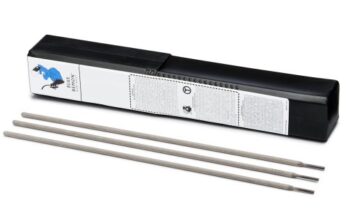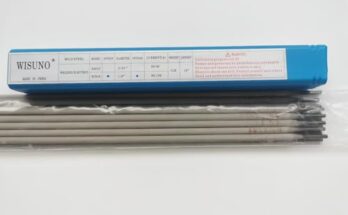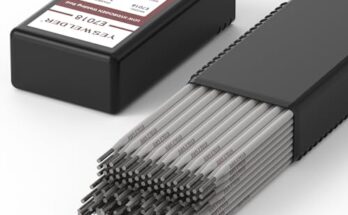Need to understand the specifics of welding stainless steel? This guide covers 316L welding rod specifications, helping you choose the right rod for your project. We’ll explore various aspects, including composition, applications, and best practices.
Let’s start with the basics. 316L stainless steel is a low-carbon austenitic stainless steel.
“Austenitic” means it has a face-centered cubic crystal structure, giving it excellent ductility and corrosion resistance. The “L” designation signifies “low carbon,” typically less than 0.03% carbon. This low carbon content is crucial; it prevents carbide precipitation during welding, which can cause sensitization and intergranular corrosion. The key alloying elements in 316L are chromium (Cr), nickel (Ni), and molybdenum (Mo). Chromium contributes significantly to corrosion resistance, forming a passive chromium oxide layer on the surface. Nickel enhances its strength and ductility. Molybdenum adds further corrosion resistance, particularly in chloride-containing environments, making it superior to 304 stainless steel in such scenarios. Think of it this way: If you’re welding in a marine environment or dealing with chemicals, 316L’s added molybdenum is like an extra layer of protection. This improved corrosion resistance makes it ideal for various applications, from medical implants to chemical processing equipment. You’ll frequently see these elements expressed as percentages in the specification sheets, and understanding their roles helps you appreciate the superior performance of 316L.
Mechanical Properties and Weldability
Beyond corrosion resistance, 316L boasts excellent mechanical properties. Its high ductility allows for easy fabrication and welding, making it a preferred choice for many applications. Its strength is comparable to other austenitic stainless steels, providing sufficient structural integrity in various applications. Furthermore, 316L possesses good weldability, meaning it fuses readily with proper welding techniques and filler materials. The low carbon content significantly contributes to its weldability, minimizing the risk of cracking or corrosion in the weld zone. I’ve personally experienced the ease of welding 316L; its smooth bead formation and lack of post-weld issues are noteworthy. Remember, choosing the appropriate welding technique (like TIG or MIG) and parameters is vital to ensure a high-quality weld. Incorrect welding parameters could compromise the strength and corrosion resistance of the final product.
Comparing 316L to Other Stainless Steels
It’s important to understand how 316L differs from other stainless steel grades. While 304 stainless steel is common and offers good corrosion resistance, 316L’s added molybdenum provides superior resistance to pitting and crevice corrosion, especially in chloride environments. 310 stainless steel, on the other hand, possesses higher nickel and chromium content, leading to better resistance to high-temperature oxidation. However, 310 is often more expensive and may be overkill for many applications where 316L suffices. Choosing the right grade depends on the specific demands of your project. Consider the environment, expected stress, and cost-effectiveness when making your decision. Think of it like choosing the right tool for the job – a screwdriver isn’t the best choice for hammering a nail. Similarly, selecting the appropriate stainless steel grade ensures optimal performance and longevity.
316L Welding Rod Specifications: Diameter and Length
Diameter Selection for Various Applications
The diameter of the 316L welding rod is a crucial specification. It dictates the weld bead size and penetration, influencing the strength and quality of the weld. Smaller diameter rods are suitable for precision welding, thinner materials, and detailed work. Larger diameter rods are used for welding thicker materials, requiring deeper penetration for stronger welds. The choice depends on the base material thickness and the desired weld bead size. For instance, a 1/16-inch diameter rod is perfect for thin-gauge stainless steel sheets, whereas a 3/32-inch or larger diameter is necessary for thicker components. Improper diameter selection can lead to insufficient penetration, creating weak welds prone to failure. I’ve seen firsthand the importance of matching rod diameter to base material thickness for optimal weld integrity.
Standard Lengths and Considerations for Procurement
Welding rods are typically available in standard lengths, although this can vary depending on the manufacturer and supplier. Common lengths include 12 inches, 18 inches, and 24 inches. When ordering, it’s essential to verify the length available to avoid purchasing inconsistencies. Longer rods may offer better efficiency for continuous welding, but storage and handling might become more challenging. Shorter rods, although potentially requiring more frequent changes, may be easier to manage, especially in tight spaces. Choosing between longer and shorter rods is a trade-off between welding efficiency and practical considerations. Always consider the specific requirements of the project and your working environment when ordering.
316L Welding Rod Coatings and Flux
Types of Coatings and Their Functions
316L welding rods often come with various coatings, each serving a specific purpose. These coatings protect the filler metal from oxidation, improve arc stability, and enhance weld quality. Common coatings include basic, rutile, and cellulose. Basic coatings are often used for welding in the flat or horizontal positions and offer good penetration and weld bead appearance. Rutile coatings enhance arc stability, making them suitable for welding in multiple positions and reducing spatter. Cellulose coatings are often used for high-speed welding applications. Understanding the coating’s role is essential for selecting the appropriate rod for a specific welding process and joint configuration. The coating isn’t just an added layer; it’s a key component affecting the quality of the weld.
Flux Role in Shielding and Weld Formation
The flux plays a critical role in shielding the weld puddle from atmospheric contamination, preventing oxidation and ensuring a clean weld. The choice of flux is often dictated by the welding process used, such as Gas Tungsten Arc Welding (GTAW) or Gas Metal Arc Welding (GMAW). GTAW often employs inert shielding gas (argon or helium) instead of relying heavily on flux. However, in GMAW, flux-cored welding wires use flux as a shielding agent and also as a source of alloying elements. The flux’s composition is precisely engineered to control the weld puddle’s characteristics and enhance the weld’s overall quality. The composition of the flux often contains ingredients that help create a protective atmosphere, and their chemical reactions influence the weld’s final properties. Neglecting this aspect can impact the weld’s metallurgical structure and lead to inferior quality.
Choosing the Right 316L Welding Rod for Your Project
Matching Rod Specifications to Application Requirements
Selecting the correct 316L welding rod is crucial for project success. The selection must align precisely with the base material’s thickness, the desired weld quality, and the welding process utilized. Thin-gauge stainless steel would require a smaller diameter rod and a coating suited to the chosen technique (TIG, MIG, etc.). Conversely, welding thicker sections requires a larger diameter rod with a coating formulated for adequate weld penetration and stability. Consider the environmental exposure post-welding as well. If the weld will be exposed to harsh environments, like saltwater, additional considerations are necessary. Selecting the wrong rod may lead to corrosion, cracking, or weakening of the weld, possibly jeopardizing the entire project. This stage requires meticulous attention to detail.
Factors Influencing Rod Selection: Welding Process and Environment
The welding process significantly influences rod selection. TIG welding (GTAW) typically uses solid 316L rods without flux, relying on inert gas shielding. MIG welding (GMAW) might utilize flux-cored wires or solid wires with shielding gas. The environmental conditions where the weld will be employed also play a critical role. If the welded joint will be subjected to high temperatures, corrosive substances, or harsh weather, choosing a rod with enhanced resistance to these factors is imperative. The longevity and integrity of the final weld directly depend on this informed decision. Incorrect selection can lead to premature failure, necessitating costly repairs or replacements.
Pre-Welding Preparations and Procedures
Surface Preparation Techniques for Optimal Weld Quality
Proper surface preparation is paramount for achieving a strong and reliable weld with 316L. This typically involves cleaning the surfaces to be welded, removing any contaminants like grease, oil, or rust. Techniques include grinding, wire brushing, or chemical cleaning. The level of cleanliness significantly impacts weldability and the overall quality of the joint. A poorly cleaned surface can lead to porosity, cracking, or incomplete fusion, compromising the strength and corrosion resistance of the weld. A clean surface ensures the proper fusion of the filler metal with the base material.
Proper Welding Techniques and Parameter Settings
Achieving optimal results with 316L necessitates meticulous attention to welding techniques and parameter settings. These settings directly influence the penetration, bead formation, and heat input into the base material. Improper settings can result in poor weld quality, characterized by porosity, cracks, or incomplete penetration. Achieving the correct settings frequently requires experience and careful experimentation. Using the right amperage, voltage, and travel speed for the chosen process is vital. Understanding the interplay between these parameters and their effects on the weld is a cornerstone of successful welding.
Post-Welding Procedures and Inspections
Inspection Methods for Ensuring Weld Integrity
Post-weld inspection is crucial to ensure the weld meets the required standards and possesses sufficient strength and corrosion resistance. Various inspection methods exist, including visual inspection, radiographic testing (RT), ultrasonic testing (UT), and dye penetrant testing (PT). Visual inspection checks for surface defects, such as cracks or porosity. RT and UT methods offer more detailed examination of internal defects. PT helps identify surface cracks. The choice of inspection method depends on the weld’s criticality and the desired level of inspection rigor. Comprehensive inspection identifies potential flaws, ensuring a safe and reliable weld.
Heat Treatment and Its Effects on Weld Properties
In some cases, heat treatment following welding might be necessary to improve the weld’s mechanical properties and corrosion resistance. Heat treatment can relieve stress in the weld and improve its microstructure. However, incorrect heat treatment parameters can result in undesirable consequences, such as grain growth or embrittlement. The necessity of heat treatment often depends on the weld’s requirements and the base material’s specifications. Careful consideration of heat treatment parameters is vital for maximizing weld performance.
Safety Precautions During 316L Welding
Personal Protective Equipment (PPE) Requirements
Welding 316L, like any welding process, necessitates stringent safety precautions. Appropriate personal protective equipment (PPE) is crucial to protect against potential hazards like ultraviolet radiation, heat, sparks, and fumes. This includes welding helmets with appropriate shade lenses, welding gloves, protective clothing, and respiratory protection. Neglecting PPE can lead to serious injuries such as eye damage, burns, and inhalation of harmful fumes. Prioritizing safety is paramount in welding operations.
Ventilation and Fume Extraction Best Practices
Adequate ventilation and fume extraction are essential when welding 316L, as the process generates fumes containing chromium, nickel, and other potentially harmful substances. Inhaling these fumes can pose significant health risks. Using local exhaust ventilation (LEV) systems effectively removes fumes at their source, minimizing exposure. Good ventilation also helps reduce the concentration of fumes in the surrounding environment. Investing in proper ventilation and fume extraction systems ensures the safety and well-being of the welder and others in the vicinity.
Frequently Asked Questions
What is 316L welding rod specifications best for?
316L welding rods are best suited for applications requiring high corrosion resistance, especially in chloride-containing environments. This makes them ideal for chemical processing equipment, marine applications, medical implants, and food processing machinery. Their excellent weldability and mechanical properties also make them suitable for various structural applications where corrosion resistance is crucial. Learn more about the specific applications of 316L welding rods by consulting industry standards and material specifications.
What are the common types of 316L welding rods?
316L welding rods are available in various forms, including solid rods, flux-cored wires, and metal-cored wires. Solid rods are typically used in gas tungsten arc welding (GTAW), while flux-cored and metal-cored wires are commonly used in gas metal arc welding (GMAW). Each type offers unique characteristics and benefits suited to specific welding applications. The choice of rod type depends on the welding process, base material thickness, and desired weld quality.
How do I determine the correct size of 316L welding rod?
The correct size of a 316L welding rod is determined by the thickness of the base material being welded. Thicker materials require larger diameter rods to ensure sufficient penetration and weld strength. Consult welding codes and manufacturers’ recommendations for guidance on appropriate rod size selection based on base material thickness. Using the incorrect size can compromise the weld’s integrity.
What safety precautions should be taken when welding with 316L rods?
Welding with 316L rods requires adherence to strict safety protocols. This includes using appropriate personal protective equipment (PPE) such as welding helmets, gloves, and clothing; ensuring adequate ventilation to remove harmful fumes; and following proper welding procedures to minimize the risk of burns, eye damage, or inhalation of hazardous fumes. Consult OSHA guidelines for detailed safety measures.
How do I store 316L welding rods properly?
Proper storage is crucial for maintaining the quality and usability of 316L welding rods. Store them in a dry, clean location, protected from moisture and extreme temperatures. Keep the rods upright to prevent bending or warping. Proper storage prevents corrosion and degradation of the filler material, maintaining the weld’s quality. Always check the manufacturer’s recommendations for optimal storage practices.
What are the common problems encountered when welding with 316L rods?
Common problems include poor weld penetration, excessive spatter, porosity, and cracking. These problems can result from incorrect welding parameters (amperage, voltage, travel speed), inadequate surface preparation, or improper rod selection. Addressing these issues often requires adjustments to welding parameters, improved surface preparation, and selection of appropriate welding rods for the specific application.
Where can I find more information on 316L welding rod specifications?
Detailed specifications on 316L welding rods are readily available from manufacturers’ datasheets, industry standards like AWS (American Welding Society) publications, and materials engineering handbooks. These resources provide comprehensive information on chemical composition, mechanical properties, and recommended welding procedures. Consulting these sources ensures proper selection and usage of 316L welding rods.
Final Thoughts
Understanding 316L welding rod specifications is key to achieving high-quality, corrosion-resistant welds. From selecting the appropriate diameter and coating to mastering welding techniques and adhering to safety precautions, every step contributes to a successful outcome. Remember, proper preparation, precise execution, and diligent inspection are essential for creating strong, reliable welds that meet the project’s demands. Start your next project confident in your ability to select and use the right 316L welding rods. By following the guidelines outlined here, you can ensure your welds are not only durable but also meet the highest quality standards.


